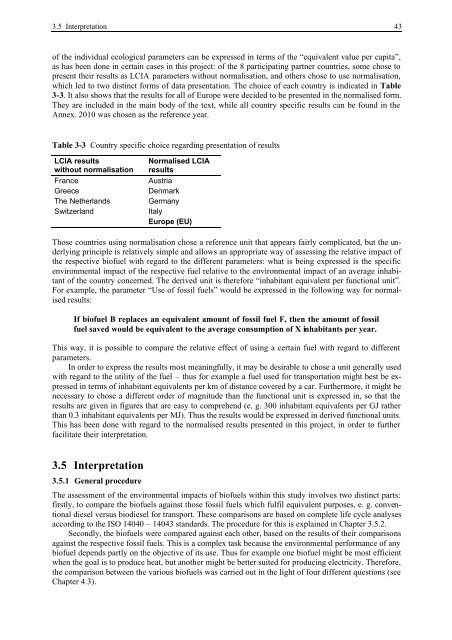BIOENERGY FOR EUROPE: WHICH ONES FIT BEST?
BIOENERGY FOR EUROPE: WHICH ONES FIT BEST?
BIOENERGY FOR EUROPE: WHICH ONES FIT BEST?
You also want an ePaper? Increase the reach of your titles
YUMPU automatically turns print PDFs into web optimized ePapers that Google loves.
3.5 Interpretation 43<br />
of the individual ecological parameters can be expressed in terms of the “equivalent value per capita”,<br />
as has been done in certain cases in this project: of the 8 participating partner countries, some chose to<br />
present their results as LCIA parameters without normalisation, and others chose to use normalisation,<br />
which led to two distinct forms of data presentation. The choice of each country is indicated in Table<br />
3-3. It also shows that the results for all of Europe were decided to be presented in the normalised form.<br />
They are included in the main body of the text, while all country specific results can be found in the<br />
Annex. 2010 was chosen as the reference year.<br />
Table 3-3 Country specific choice regarding presentation of results<br />
LCIA results<br />
without normalisation<br />
Normalised LCIA<br />
results<br />
France Austria<br />
Greece Denmark<br />
The Netherlands Germany<br />
Switzerland Italy<br />
Europe (EU)<br />
Those countries using normalisation chose a reference unit that appears fairly complicated, but the underlying<br />
principle is relatively simple and allows an appropriate way of assessing the relative impact of<br />
the respective biofuel with regard to the different parameters: what is being expressed is the specific<br />
environmental impact of the respective fuel relative to the environmental impact of an average inhabitant<br />
of the country concerned. The derived unit is therefore “inhabitant equivalent per functional unit”.<br />
For example, the parameter “Use of fossil fuels” would be expressed in the following way for normalised<br />
results:<br />
If biofuel B replaces an equivalent amount of fossil fuel F, then the amount of fossil<br />
fuel saved would be equivalent to the average consumption of X inhabitants per year.<br />
This way, it is possible to compare the relative effect of using a certain fuel with regard to different<br />
parameters.<br />
In order to express the results most meaningfully, it may be desirable to chose a unit generally used<br />
with regard to the utility of the fuel – thus for example a fuel used for transportation might best be expressed<br />
in terms of inhabitant equivalents per km of distance covered by a car. Furthermore, it might be<br />
necessary to chose a different order of magnitude than the functional unit is expressed in, so that the<br />
results are given in figures that are easy to comprehend (e. g. 300 inhabitant equivalents per GJ rather<br />
than 0.3 inhabitant equivalents per MJ). Thus the results would be expressed in derived functional units.<br />
This has been done with regard to the normalised results presented in this project, in order to further<br />
facilitate their interpretation.<br />
3.5 Interpretation<br />
3.5.1 General procedure<br />
The assessment of the environmental impacts of biofuels within this study involves two distinct parts:<br />
firstly, to compare the biofuels against those fossil fuels which fulfil equivalent purposes, e. g. conventional<br />
diesel versus biodiesel for transport. These comparisons are based on complete life cycle analyses<br />
according to the ISO 14040 – 14043 standards. The procedure for this is explained in Chapter 3.5.2.<br />
Secondly, the biofuels were compared against each other, based on the results of their comparisons<br />
against the respective fossil fuels. This is a complex task because the environmental performance of any<br />
biofuel depends partly on the objective of its use. Thus for example one biofuel might be most efficient<br />
when the goal is to produce heat, but another might be better suited for producing electricity. Therefore,<br />
the comparison between the various biofuels was carried out in the light of four different questions (see<br />
Chapter 4.3).

















